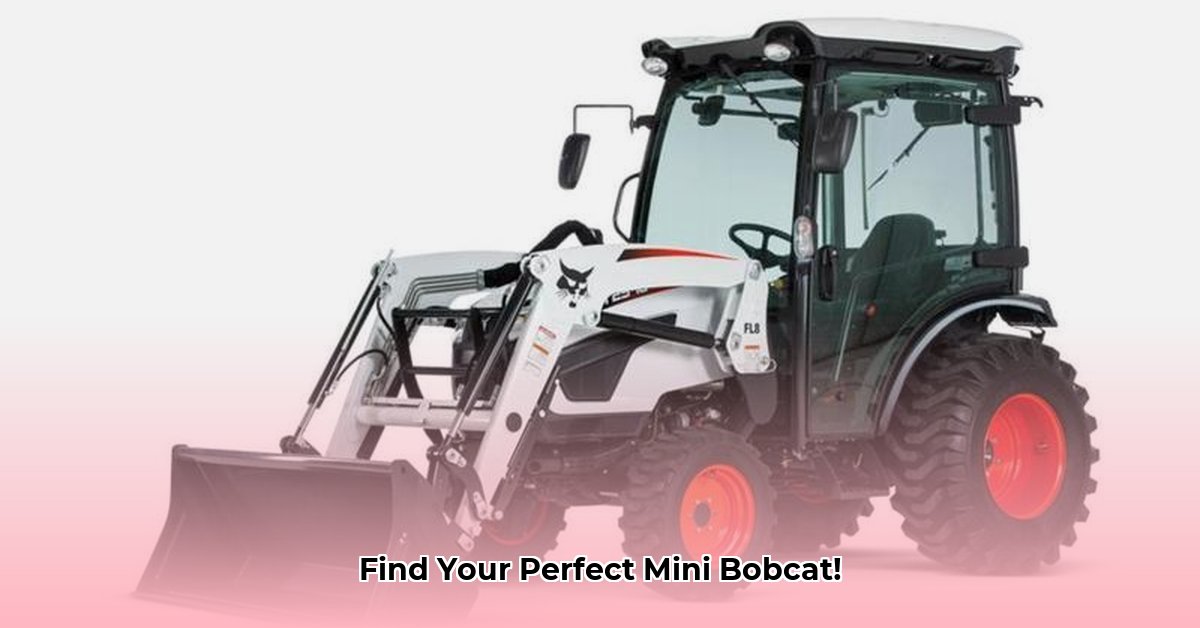
Choosing the right small tractor can be daunting. This comprehensive guide simplifies the selection process for Bobcat compact and sub-compact tractors, helping homeowners, small farmers, and landscapers find the perfect fit for their needs and budget. We'll compare models, delve into key features, and provide a step-by-step process to ensure you make an informed decision. For even more details, check out this helpful guide: Bobcat Tractor Guide.
Understanding Bobcat Tractor Model Lines
Bobcat offers several tractor platforms, each designed for specific applications. Choosing the right platform is akin to selecting the right tool for the job; a hammer won't replace a screwdriver. Understanding the distinctions between Bobcat's 1000, 2000, 4000, and 5000 series is crucial for making the best choice.
1000 Series: Entry-level models, ideal for light-duty tasks on smaller properties. Perfect for homeowners needing a tractor for mowing, light landscaping, and general property maintenance. Think of these as the "handyman" tractors.
2000 Series: Offering a step up in power and capability compared to the 1000 series. Suitable for heavier landscaping, small-scale farming, and moving larger amounts of materials. More versatile than the 1000 series.
4000 & 5000 Series: These are the heavy-duty workhorses, designed for demanding jobs on larger properties or farms. They boast significantly higher horsepower and lift capacity, making them ideal for serious farming operations and moving heavy materials. These are the "workhorses" of the Bobcat lineup.
The following table provides a comparison of key specifications:
| Platform | Horsepower Range | Lift Capacity (lbs) (Approximate) | Transmission Options | Cab Options | Typical Applications |
|---|---|---|---|---|---|
| 1000 | 21-25 | 700-1000 | Hydrostatic | Open | Light landscaping, property maintenance, mowing |
| 2000 | 26-34 | 1200-1700 | Hydrostatic, Manual | Open, Enclosed | Heavier landscaping, small-scale farming, material moving |
| 4000 | 45-58 | 2200-3177 | Hydrostatic | Enclosed | Larger farms, significant material handling, tough jobs |
| 5000 | 45-58 | 2200-3177 | Hydrostatic, Electronic Hydrostatic | Enclosed | Larger farms, significant material handling, tough jobs |
Note: Lift capacities are approximate and may vary based on model and configuration. Consult official Bobcat specifications for precise figures.
Key Features and Considerations
Beyond the basic model lines, several crucial features will shape your decision. Let's examine the most important factors:
Power and Lift Capacity
Horsepower dictates how efficiently the tractor completes tasks, with higher horsepower accommodating more demanding work. Lift capacity determines the maximum weight the tractor's loader can lift, critical for moving heavy materials such as hay bales or gravel. For instance, the 4000 and 5000 series' higher lift capacities are ideal for handling substantial loads. Isn't it important to know how much weight your tractor can safely lift?
Transmission Types
Bobcat tractors typically feature hydrostatic transmissions, known for smooth and easy operation. Some models also offer manual transmissions, providing more control but requiring greater operator skill. Hydrostatic is generally recommended for ease of use, especially for novice operators. What level of control do you need for your farming operations?
Cab Options
Open-station tractors offer superior visibility but expose the operator to the elements. Enclosed cabs provide enhanced comfort and protection from weather, noise, and debris. The choice depends on your personal preference and the typical weather conditions you’ll be working in. Which cab option best suits your climate and comfort needs?
Three-Point Hitch and Implement Compatibility
The three-point hitch is for attaching implements like tillers, mowers, and backhoes. Bobcat sub-compact tractors use a "Limited Category 1" three-point hitch, limiting compatibility with certain larger attachments. Always confirm implement compatibility before purchasing. Is your preferred equipment compatible with your chosen Bobcat tractor model?
Choosing the Right Bobcat Tractor: A Step-by-Step Guide
Selecting the ideal tractor hinges on your specific requirements. Follow these steps for a successful purchase:
- Assess Your Needs: Determine your property size and the tasks you'll be performing. This helps define the necessary horsepower and lift capacity.
- Budgeting: Establish a realistic budget, considering the tractor’s price, maintenance costs, and potential repairs.
- Model Comparison: Utilize the table above and the Bobcat website to compare model specifications, focusing on horsepower, lift capacity, transmission, and cab options.
- Attachment Verification: Ensure compatibility of essential implements with your chosen model, keeping in mind the "Limited Category 1" hitch limitation.
- Test Drive (If Possible): A test drive allows you to experience the tractor's operation and maneuverability firsthand. This is strongly recommended.
- Choose a Reputable Dealer: A trustworthy dealer offers expert advice, post-sale support, and financing options.
Conclusion: Find Your Perfect Tractor Partner
Carefully considering your needs, comparing models, and understanding key features are essential for selecting the right Bobcat tractor. Consult with a reputable dealer to ensure your choice aligns perfectly with your requirements. With the right machine, you'll efficiently and effectively tackle your projects for years to come. Remember, the best tractor is the one that best fits your work style and needs.